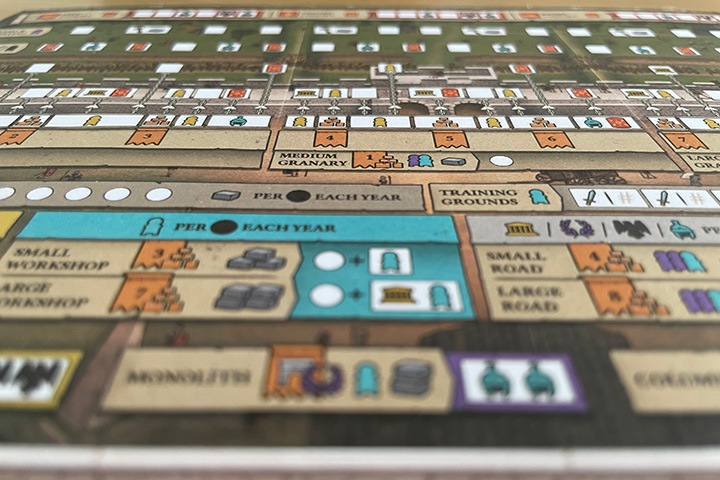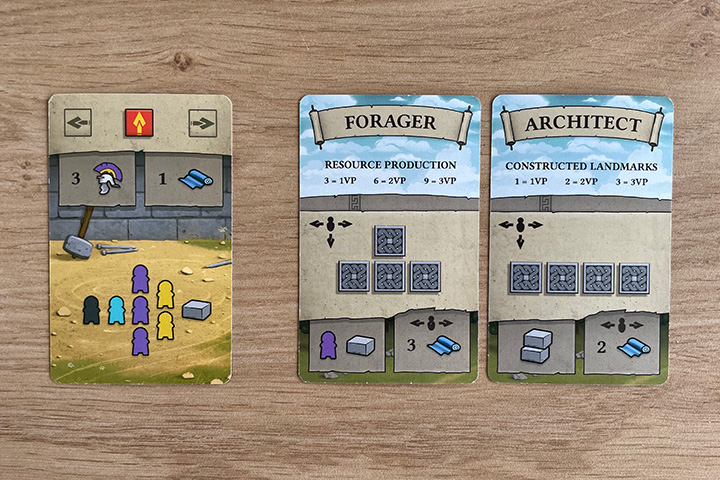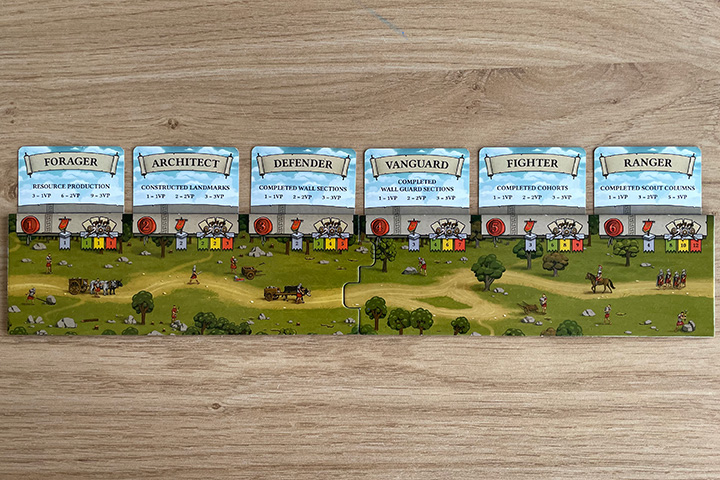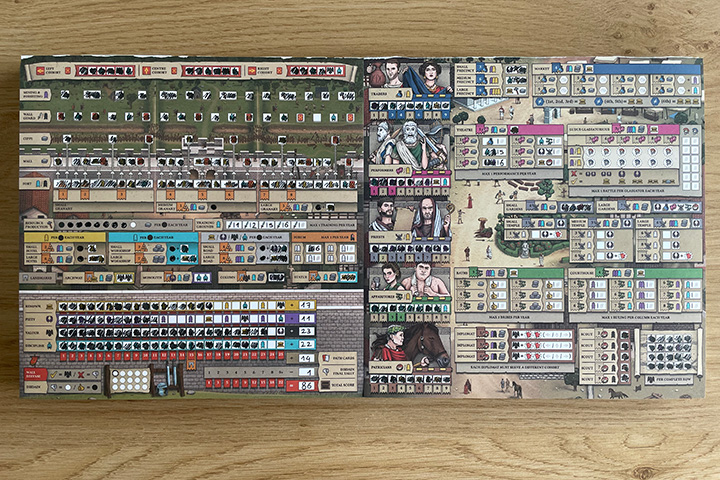Hadrian's Wall - A Solo Review
24 Aug 2021
It’s 122 AD and there’s lots of unrest in the Roman province of Britannia. Emperor Hadrian orders a large wall to be built, going from coast to coast, to prevent the savage Picts in the North from raiding the Roman empire.
You’re one of the Roman generals tasked with overseeing the construction of part of the wall and the accompanying milecastle. Will you make emperor Hadrian proud, or will the Picts make fun of your effort?
Name: Hadrian’s Wall
Designer: Bobby Hill
Publisher: Garphill Games
Game type: Flip and write
What is Hadrian’s Wall?
Hadrian’s Wall can be seen as an advanced flip and write game. The game consists of two big sheets of paper where you will be filling in boxes for every action you take.
In the game, your goal is to manage the construction of a part of Hadrian’s famous wall. You’ll be building more than the just the wall and a fort though! The soldiers manning the wall will need a place to live and relax, so you’ll also be taking care of a attracting civilians by building services and providing entertainment. Since all work and no play makes Jackianus a dull boy, you’ll have to fend off the attacking Picts as well.
All that is done by filling in boxes on the sheets.

Every action you take will potentially earn you renown, piety, valour or discipline, which, together with variable goals you get during the game, will score you points at the end of the game.
How does it play?
You start the game by taking one of each sheet of paper and placing them next to each other. The left sheet contains everything related to the defensive structures you can build: the wall, the wall guard, the fort, … The right sheet is dedicated to the civilians living near the fort and the services they provide.
Both sheets contain loads and loads of boxes you need to fill. Most of them are laid out in tracks, meaning they need to be filled in from left to right. In most roll and write or flip and write games, you determine what you can fill in or write by rolling some dice or flipping some cards. In Hadrian’s Wall boxes have a cost you need to pay before you can fill them in. These costs are in the form of one or more workers, resources or a combination of both, and they are indicated on the sheets themselves.
These workers come in four different colours: black soldiers, blue builders, purple servants and yellow civilians. There is only one type of resource: stone. The game still uses the generic term resources though.

So we know you need to have workers and resources to fill in boxes, but how do you get them? That’s where the cards come into play (pun not intended) and why people call Hadrian’s Wall a flip and write game.
There are two decks of cards in Hadrian’s Wall. A big fate deck and a smaller personal deck consisting of only 12 cards. At the beginning of each of the six rounds you flip a card from the fate deck. This card will tell you which workers and how many resources you get to start the round with. It could for example say one soldier, two builders, two servants, two civilians and one resource. In addition to that, you also flip over two cards from your personal deck. Both cards contain a path (goal) at the top and extra workers and/or resources at the bottom. You will select one card for its path (the path card) and one card for its workers and resources (the prospect card).

Once you have gathered all your workers and resources at the beginning of a round you are free to spend them however you want to. Filling in a box on the wall will cost you one resource. Filling in a box on the fort will cost you either a soldier or a builder. Building a theater will cost you a builder, a servant and a resource. Everything has its cost, and in addition to that, a lot of things can only be done once you have advanced enough on specific tracks. Building a small garden, for example, will cost you a builder, a servant and a resource, but you also need to have filled in at least four boxes on the priests track.
Some boxes are empty, but some contain a reward you will earn when you fill it in. This is where Hadrian’s Wall starts to shine. You could for example use a builder to fill in a box on the fort, which will give you an extra civilian. You can use that civilian to fill in a box on the performers citizen track, which will give you an extra builder. You can use that builder to fill in another box on the fort, which will give you a discipline. This allows you to fill in a box on the discipline track, which could give you another builder. Halfway through a round you can think you don’t have a lot of options with those three workers and one resource you have left, but then you kick off a combo and before you know it you have filled in 8 boxes and still have workers left.
When you are out of workers and resources (or out of things to do with them) the round ends and the Picts attack! Your player board indicates how many Picts will attack this round, and that’s how many cards of the fate deck you need to reveal. The top of those cards have an arrow pointing either upwards, to the left or to the right. Group the cards by the direction the arrow is pointing to and compare the amount of cards to the boxes of the cohorts (a section of the wall) you have filled in. If you have filled in more boxes than there are cards, you have successfully defended that part of the wall. If there are more cards than filled in boxes, you get a disdain per card. Disdain is worth negative points in the game. Luckily there are also ways to get rid of disdain and other ways to fend of attacks in case you don’t want to invest in the cohorts.


After six rounds you count up the number of boxes you have filled in on the renown, piety, valour and discipline tracks, add the points from the six path cards you’ve gathered over the rounds, subtract disdain and you will have a final score.
How does the AI work?
The AI in a solo game is there to replace actual human opponents. When you play Hadrian’s Wall with other people, you don’t really play against each other. Sure, you compete for the best score, but you don’t actually have a lot of interactions. In fact, many people describe it as a multiplayer solitaire game: people simultaneously playing a solo game.
That’s why there’s no AI opponent in this game.
The limited form of interaction you get in a multiplayer game consists of being able to use your direct neighbours’ prospect card for the trade and scout actions. When doing that, you would give that player a soldier or a resource in return for using the trade value or the scouting pattern on their card.
In the solo game you take an extra player deck and each round you reveal two cards. These represent the prospect cards of your missing neighbours. If you want to take the trade or scout action, instead of giving a soldier or a resource to a neighbour, you place that soldier or resource on the neutral card you want to use.
At the end of the round, when you draw cards for the attacking Picts, you just draw one extra attack card per soldier or resource you have placed on the neutral cards. This is done to make it less appealing to do that, since in a multiplayer game you don’t really want to be giving your opponents extra soldiers and resources either.
What does it look and feel like?
Let’s start with the sheets. The sheets contain a lot of information, but the way all of it is presented and divided into areas and tracks really makes everything very manageable. The iconography is very clear and also helps in making everything easy to process. You’ll probably feel overwhelmed during your first game, but that will be more because of the sheer amount of options you have and less because of how they are presented.

The workers and resources are very well done. The workers have tiny legs and the resources have tiny dents. These are just small details, but they add a nice touch. I’ve heard that people with colour blindness can have a hard time distinguishing between the blue builders and the purple servants, so that might be something to take into account.
The cards are of the same quality as in other Garphill Games games. In Viscounts and Paladins of the West Kingdom I started getting some white edges around the corners of the cards, so I decided to sleeve the cards in those games, but I don’t feel that need in Hadrian’s Wall. You don’t really shuffle the cards a lot, and the background of the cards is a bit lighter than in the other games, so I don’t think potential white edges will stand out that much. I haven’t seen any so far, at least.
The only thing about the components that’s a bit annoying are the player boards. Instead of having foldable player boards like in Paladins of the West Kingdom or Raiders of Scythia, Hadrian’s Wall has player boards that are made of two pieces which need to be “puzzled” together. Whenever you need to slide a new path card under the player board you need to lift it slightly and that causes the two pieces to come apart.
Other than that, I really like the production quality of this game.
How much time does it take?
Let’s start with setup and teardown.
Setup is pretty simple. Take the two stacks of sheets, take two pieces to assemble your player board, shuffle some cards and put the workers and resources in containers if you want to and that’s it. Teardown is the exact opposite. Of all my games, this one requires the least amount of setup and teardown compared to the time it takes to play the game.
The box says the game takes between 30 and 60 minutes. I don’t think I have ever been able to finish it in that time. My first few games easily took between 90 and 120 minutes. After about 10 plays, I think I’m averaging around 90 minutes, including setup and teardown. I have to say that I tend to take my time thinking over my options. When playing any game with others I’m usually the slowest player. Maybe you could play it in about an hour, but the advertised 30 minutes still feel like a stretch for most people.

I don’t have a problem with the 90 minutes though. It doesn’t feel like 90 minutes. Some games can overstay their welcome and feel like they could do with fewer rounds. That’s not the case with Hadrian’s Wall as far as I’m concerned.
What is my verdict?
I initially dismissed Hadrian’s Wall because it looked too daunting and complicated. Because the game kept popping up in the Facebook groups I’m in and people were very enthousiastic about it, I decided to give it a chance after all and I am very glad I did!
It looks complicated but it definitely isn’t; the rules are actually very simple. While it isn’t complicated, it can be a bit complex because there are so many things to do and you’re often trying to play out potential combos in your head before you actually fill in boxes. If you’re prone to analysis paralysis (guilty as charged) all these options can make the game last longer than the box indicates, but I’ve never felt it took too long. I’ve never thought “Ugh, another round?”.
The only negative thing I can come up with is that while there are many different strategies and combinations to try out, it does feel like there are a few things you will always want to do in order to get a big score. Maybe I just need more experience in the other areas of the game though.
If you like optimisation and efficiency, this is a game for you. If you like losing yourself in a game trying to solve a puzzle, this is a game for you. If you like roll/flip and writes games and are not afraid to try something more advanced, this is a game for you.
Score
To make things easier for myself, I use the same scoring categories Board Game Geek uses.
Comments
I'm sorry, I don't support comments on my website. If you want to discuss the game or my review, feel free comment on this dedicated Instagram post or my review on BGG.